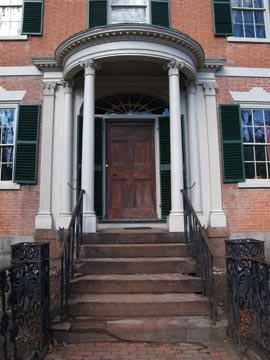Samuel McIntire, Carving an American Style
At the Peabody Essex Museum until February 24, 2008
 I learned of Samuel McIntire after moving to Marblehead years ago. Rumor had it that the mantel in the Federal Style home that we were renting was a McIntire original. I became intrigued by his work. When we moved to Salem, McIntire’s buildings seemed to pop up everywhere. There’s a reason for that; according to the exhibit, McIntire was responsible for the design of more than 50 public buildings, churches, and private residences in Salem between 1780 and 1811. We have him to thank for many of Salem’s most elegant neoclassical structures.
I learned of Samuel McIntire after moving to Marblehead years ago. Rumor had it that the mantel in the Federal Style home that we were renting was a McIntire original. I became intrigued by his work. When we moved to Salem, McIntire’s buildings seemed to pop up everywhere. There’s a reason for that; according to the exhibit, McIntire was responsible for the design of more than 50 public buildings, churches, and private residences in Salem between 1780 and 1811. We have him to thank for many of Salem’s most elegant neoclassical structures.
It was my interest in him as an architect that led me to the Peabody Essex Museum. The exhibit includes a sampling of his original architectural drawings. I was particularly fascinated by the entry he submitted to the 1792 international design competition for the U.S. Capital in Washington, D.C. He would have been 35 or so at the time, an impressive age to be vying for so significant a commission. President Washington rejected his entry along with 16 others. Fortunately, McIntire would have plenty of other successes.
As the exhibit title suggests, it’s McIntire's wood carvings that garner most of the show’s attention. An exquisite pine carved Corinthian capital c. 1796-1800 caught my eye at the exhibit entrance. The “jagged-edge acanthus leaf” is very impressive. Much of the furniture on display from the Federal period includes his low-relief (appliqué) carvings with a variety of agrarian and domestic themes. It was a particularly patriotic time, so there are many carved eagles in the mix too. They're more three-dimensional and served as free-standing accent elements atop elaborate buildings and furniture pieces. George Washington’s visage is captured in shallow silhouette on many plaques as well.
One of the exhibit highlights is a large-screen video of Philip Lowe, a master craftsman in Beverly, Mass., carving a replica of a McIntire rosette. We see Lowe work the wood up-close, demonstrating some of the techniques McIntire likely used. A nearby computer includes an interview with Lowe in which he describes the process and how McIntire might have worked. Watching Lowe skillfully peel away wood to reveal discreet details was mesmerizing.
Another exhibit success can be found in one of the last rooms. There you’ll find groupings of similar carved items from which you are challenged to identify an original McIntire. For instance, there are three shield–back chairs on display and three corresponding covered plaques that, when opened, reveal the identity of each craftsman and piece. These test your observational skills and, by making a game out of it, engage your interest. There are a couple winners in each group, which improves your odds of feeling like quite the connoisseur.
Whether or not McIntire is new to you, you’ll find something captivating at the PEM exhibit. For me, the enormous pine Ionic capital from South Church (which was destroyed by the fire of 1903) was one of the greatest finds. Go see what strikes your fancy.
by Katie Hutchison for the House Enthusiast